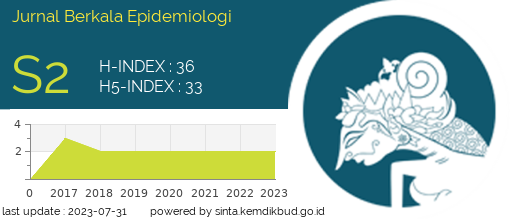Catheter Associated Urinary Tract Infection Based on Surveillance Attributes in RSU Haji Surabaya
Downloads
The surveillance system is very instrumental in reducing the incidence of nosocomial infections, so the nosocomial infection surveillance system needs to be implemented in hospitals. Catheter-associated Urinary Tract Infection (CAUTI) surveillance is one of the program's focuses on infection prevention and control efforts at the Haji Public Hospital (RSU Haji) Surabaya in 2015. The success of a surveillance system is highly dependent on the interrelation of the attributes contained therein. In 2015, there was a delay in the collection of reports exceeding the specified deadline and there were also columns in the confirmation sheet that were not filled. This study aims to evaluate CAUTI surveillance based on surveillance attributes at the RSU Haji Surabaya in 2015. This study is an evaluative descriptive study. The variables studied were CAUTI surveillance attributes at RSU Haji Surabaya, namely simplicity, flexibility, acceptability, sensitivity, positive predictive value, representativeness, timeliness, data quality, and stability, while the research respondents were Infection Control Nurse (ICNs), Infection Control Link Nurses (ICLN), and the head of the room. Data collection techniques carried out by interview and documentation study. The results showed that the surveillance attributes were simple, had high acceptability, high sensitivity, high positive predictive value, representative, and high stability. However, other attributes are inflexible, not timely, and have low data quality. Alternative solutions that can be done are improving supervisory functions in each unit, establishing hospital data standardization, setting reward, and punishment systems.
Arana, Carolina., 2009. Assessment and Comparison of Behavior Risk Factor Surveillance Systems for the U,S., Canada, and Italy. Thesis. Geogia State University.
Barr C., Hoefer D., Cherry B. Noyes KA, 2011. A Process Evaluation of an Active Surveillance System for Hospitalized 2009-2010 H1N1 Influenza Cases. Tersedia di: <http://www.ncbi.nlm.nih.gov/pubmed/21135655> [diakses tanggal 2 Juni 2016].
CDC, 2001. Updated Guidelines for Evaluating Public Health Surveillance System Recommendations from the Guidelines Working Group.Tersedia di:http://www.cdc.gov/mmwr/pdf/rr/rr5013.pdf [diakses tanggal 22 Desember 2015]
ECDC, 2014. Data Quality Monitoring and Surveillance System Evaluation. Stockholm: European Centre for Disease Prevention and Control.
Gould, Carolyn., Umscheid, Craig., Agarwal, Rajender., MSW, Gretchen., Pegues, David., 2009. Guideline for Prevention of Catheter Associated Urinary Tract Infections 2009. USA: Departement of Health and Human Service.
Guerra. J.M. Bachir, D. Ali, L. M. Mahamane, E.L. Augusto, F.G. Rebecca., 2012. Evaluation and Use of Surveillance System Data Toward The Identification of High Risk Areas for Potential Cholera Vaccination: A Case Study From Niger. BMC Researce Notes, 5 (231):pp.1-7. Tersedia di:<http://www.biomedcentral.com/content/ pdf/1756-0500-5-231.pdf> [diakses tanggal 18 Juni 2016]
Herlambang dan Muwarni, 2012. Cara Mudah Memahami Manajemen Kesehatan dan Rumah Sakit. Yogyakarta: Gosyen Publishing.
Hooton, T.M., Bradley, S.F., Cardenas, D.D., Colgan, R., Geerlings S.R., Rice, J.C., et al., 2010. Diagnosis, Prevention, and Treatment of Catheter Associated Urinary Tract Infection in Adults.International Clinical Practice Guidelines from the Infectious Diseases Society of America, 50: pp. 625–663.
Kartono, 2006. Profesi dan Praktek Keperawatan Profesional. Jakarta: EGC.
Keputusan Menteri Kesehatan Republik Indonesia Nomor 129 Tahun 2008 Tentang Standar Pelayanan Minimal Rumah Sakit.
Keputusan Menteri Kesehatan Republik Indonesia Nomor 1116 Tahun 2003 Tentang Pedoman Penyelenggaraan Sistem Surveilans.
Loustalot, F., 2012. CDC Coffee Break: Streamlining the Evaluation of Public Health Surveillance System. CDC.
Murti, Bhisma. 2003. Prinsip dan Metode Riset Epidemiologi. Yogyakarta: Gadjah Mda University Press.
NHSN. 2006. The National Healthcare Safety Network at the Center for Disease Control and Prevention. Infection Control and Hospital Epidemiology.29:pp.996-1011. Tersedia di:<http://www.jstor.org/stable/10.1086/591861> [diakses tanggal 18 Juni 2016]
Notoatmodjo, S., 2010. Metode Penelitian Kesehatan. Jakarta: Rineka Cipta.
Noor, Nur. Nasy., 2008. Epidemiologi. Jakarta:Rineka Cipta.
Raras, Sanityasa., 2011. Evaluasi Sistem Surveilans Ventilator Associated Pneumonia (VAP) di Rumah Sakit "X” Surabaya. Skripsi. Surabaya: Universitas Airlangga.
Rumah Sakit Umum Haji Surabaya, 2013. Pedoman Teknis Pencegahan dan Pengendalian Infeksi. Surabaya: Unit Pencegahan dan Pengendalian Infeksi (PPI).
Septiari, Betty. Bea. 2012. Infeksi Nosokomial. Yogyakarta: Nuha Medika.
Vebrilian, Spica., 2016. Evaluasi Sistem Surveilans Infeksi Nosokomial Catheter Associated Urinary Tract Infection di RSU Haji Surabaya Tahun 2015. Skripsi. Surabaya: Universitas Airlangga WHO. 2006. Communicable Disease Surveillance and Response Systems, Guide to Monitoring and Evaluating.
WHO. 2011. Report on the Burden of Endemic Health Care Associated Infection Worldwide. Geneva.
Wilkins K, Nsubuga P, Mendlein J, Mercer D, Pappaioanou M., 2008. The Data for Decision Making Project: Assessment of Surveillance Systems in Developing Countries to Improve Access to Public Health Information. Public Health, 2(9): pp. 914–922.
- Every manuscript submitted to must observe the policy and terms set by the Jurnal Berkala Epidemiologi
- Publication rights to manuscript content published by the Jurnal Berkala Epidemiologi is owned by the journal with the consent and approval of the author(s) concerned. (download copyright agreement)
- Complete texts of electronically published manuscripts can be accessed free of charge if used for educational and research purposes according to copyright regulations.

JBE by Universitas Airlangga is licensed under a Creative Commons Attribution-ShareAlike 4.0 International License.























